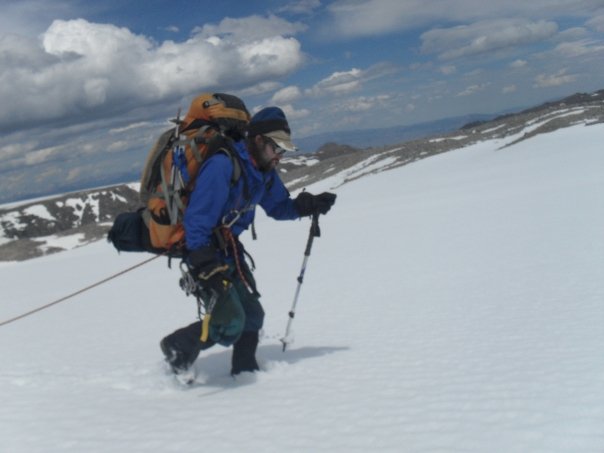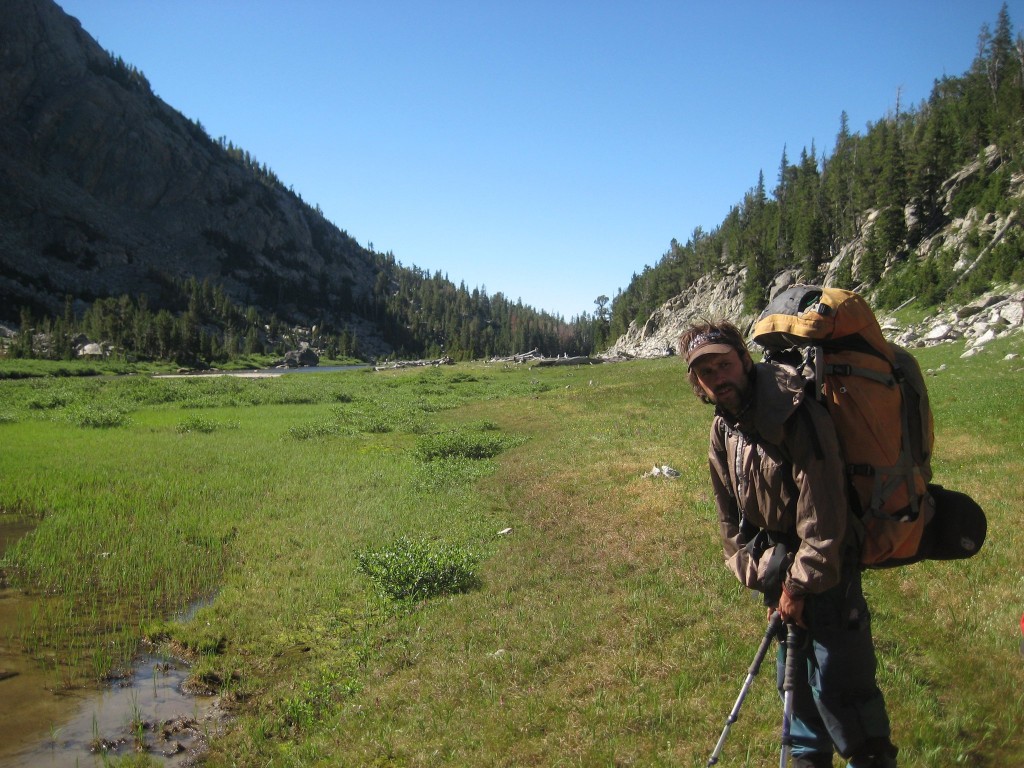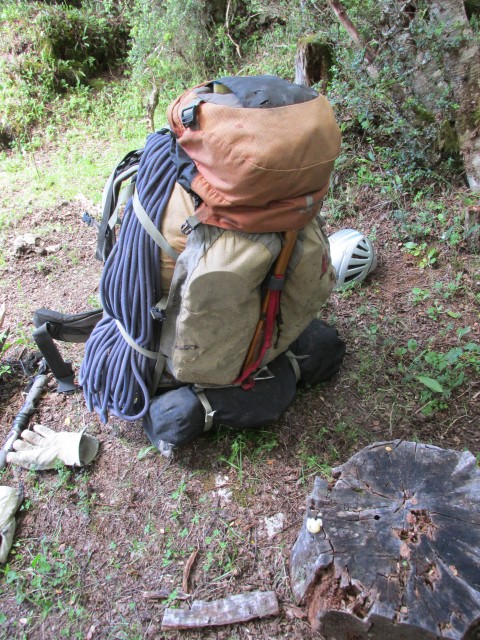(Editor’s note: For a long time I have wanted to start a series of blog posts about gear that works. In reality, all I really need is one to start, potentially that could have been Thirteen Years and Counting which was about my MSR Whisperlite. It seems though that I wrote this a long time ago and I would like to make it a more regular occurrence. After retiring a recent item, I was inspired to give it a eulogy here.)
Four of us are sitting along the Estero Sur of Chilean Patagonia’s Rio Resbalon. After three weeks of trying to climb a still unclimbed face, we are walking out. The bright red flower of the fuscia dangle from its paper barked stem. Above us various varieties of nothofagus provide us a bit of cover from the light rain. We have paused for another break after a long hour of bushwacking. Cookies have been passed around and water has been drank. We generally sit in tired silence, which I break. “If there is one thing I am good at” I say to no one in particular, “it is carrying heavy loads, over rough, varied terrain. ” This load, specifically, is one of the heavier ones I have ever carried.
“Yep, too bad there is no money in it” one of my expedition mates responds.
“Nope, not getting rich, that is for sure, at least not with money.”
As a thirty-six year old full time NOLS instructor, I have and will continue to carry my fair share of heavy loads. From ascending the Raven Headwall in Alaska’s Chugach Range with ten days of food (plus an ailing student’s gear) to 14 day rations on mountaineering courses in the Wind River Range to walking out of the Avellano Towers in Chilean Patagonia, the vast majority of my heavy loads have been carried with a Dana Designs Astralplane. Maybe that is why I am good at it.

It seems strange to be reviewing and/or recommending a piece of gear that is no longer in production, maybe even counterproductive to me acquiring more, but I feel the need to express my gratitude toward Dana Gleason, his former company and the load monster he created.
Started in Bozeman, MT in 1985 by Dana Gleason and Renee Sippel-Baker, Dana Designs created a line of backpacks that quickly became sought after for their durability and load carrying capacity. The business was quickly bought up by a company that would later become K2. After his business partner and Dana left K2 in 1997 and 1999 respectively, K2 kept the name and design, eventually passing the design onto Marmot. The brand Dana Designs was discontinued in 2006, though some of the designs stayed with Marmot for a few more years.
My first encounters with a Dana Designs backpack were working for Trails Wilderness School in Kelly, WY. While leading a 21 day backpacking trip in the Wyoming Range, two of my students had Dana Design backpacks. I remember thinking about how my students had better gear than I did. At one point, one of the students, Chuck, had taken off the lid and used it as a lumbar pack with the removable hipbelt. He was struggling to reattach the lid and I tried to help him. “This must be sewn backwards” was my slightly frustrated response after several minutes of being unable to weave the flat webbing through the ladderlock buckles without a twist. Eventually we let the twist be, me thinking that for such an expensive pack, it sucked that it wasn’t sewn correctly. I learned later, that as usual, it was operator error: reattach the lid in an upside down fashion. It is a lesson I think about every time I put the lid back on my pack.
Regardless, next summer I showed up with my very own Dana Designs Astralplane, this one was the Overkill model, which was sewn with extra beefy nylon to help it take normal wear and tear. I had gotten the bag from my friend, mentor, instructor and climbing partner Jay Miller along with a pair of BD trekking poles. Jay, after having made an attempt on Denali, no longer needed such a large heavy pack and I having done nothing of the sort, wanted one badly.
Another two season of backcountry courses at Trails, a NOLS instructor course along with twelve months of wilderness therapy work in the unforgiving sand, cactus and rough rock of the UT desert and I was more than satisfied with my Astralplane. It was living up to its reputation and Overkill name. Somewhere along the line though, abrasion took it’s toll on the Dana’s notorious weak spot, the bottom of the internal stay, and the yellow fiberglass started showing through. I did some research and then sent it back to Bozeman for repair. Three weeks later a brand new pack showed up in the mail. I was outraged.
The new pack was of the Vietnam generation. It was lighter and redesigned but more importantly not my pack and not made in Bozeman. (I have sentimental attachment issues to gear.) After a long discussion on the phone with the customer service representative, who assured me, that if it was tough enough for Navy Seals, it was tough enough for me. I accepted the fact that they no longer had track of my pack and it could not be sent back to me. Repair was not always a feasible option for the amount of business they were conducting. It had grown too big.
But now I knew the weakness. I looked at my new pack and noted the condition it was in. A trip to Alaska’s Mount Hunter, more punishing Utah desert work and a few more NOLS courses passed before I even began to see the wear and tear in the usual spots, which in addition to what was mentioned was also the top of the interior frame stay. A liberal coating of Aqua Seal was applied as a preventive measure. But then, somewhere, not long after, the pack known as Shaniqua came into my life.

In the course of my personal and professional experience, I have carried a number of different brands and models of load monster backpacks. Lowe Alpine Kanga Himals, NOLS packs by Lowe Alpine and Deuter, the Gregory Denali, Lowe Alpine’s Contour IV, Osprey Crescent 110 and 90s, an unknown model by Granite Gear and of course, a number of Dana Design Astralplanes. One thing Dana got correct was the width to height ratio. It is a wide pack, with lots of volume from hip height up to shoulder height or slightly above. There is no extending collar that could lead to topsy turvy top heavy loads. An efficient and knowledgeable packer can put a lot of stuff in areas that lead to well balanced loads. Another key feature is the mix of support and comfort in its hip belt. It’s interchangeable hipbelt pads well but is connected in a way that allows direct weight transfer from its combination of plastic frame sheet and fiberglass frame stays. The interchangeable hipbelt with many sizes, in combo with several non-adjustable torso length sizes on the bag itself allows for a fully padded back pad. Other packs have adjustment systems that just are NOT comfortable against the back, mostly they are too hard. It has two sewn on shoulder straps at a width that, unlike most other major manufacturers, do not come in a V, are not adjustable and for me, do not pinch my neck and the muscles in the upper center of my back. They come straight over the shoulder, not at an angle. The main feature though, is its volume. Yes, empty the pack weighs eight or nine pounds but durability, functionality and fit come with a price. There are few packs out there that can carry so much weight and volume. No pack can make seventy pounds feel light, but an Astralplane can at least make it feel comfortable.
Shaniqua was a late model Dana Design Astralplane, probably the last incarnation before the model was taken over with the Marmot logo. Made in Vietnam, new it was orange and black with grey straps. I carried the pack on several courses before its name came about. Shaniqua is the name of a song by Little T and Mr Mike. The refrain, something like “Shaniqua don’t live here no mo’, Is Shaniqua there? Hell no. Shaniqua don’t live here no mo” and song, were introduced to me by Robin Larson on her NOLS Instructor Course. She had used it while educating some youngsters as a means to keep them engaged. The song relays the experience of someone whose phone number is Shaniqua’s old phone number; people keep calling the number, looking for Shaniqua. One caller says “this is for the kid livin’ with Shaniqua, you want that trick you can keep her” What drew me to the name, is the line about Shaniqua not living here no more. Dropping the burdensome sack onto the ground, it felt good to say that she didn’t live there no more.
Today, with the loss of a quality pack and company, I find myself scouring Ebay and the internet, gear consignment shops and NOLS issue rooms to find an odd left over antiquated beast. In the fall of 2014 I found my heart’s desire in a pile of packs at the NOLS Pacific Northwest. It was a Bozeman era red Astralplane and it was in usable condition. I borrowed it for the mountain section I was working and then upon hearing that Russell was looking to off load them this fall, offered to take it off his hands. We agreed on a price and despite a repair on it’s weakness, I walked away happy, with something to replace Shaniqua when the time came.
Shaniqua had seen only a handful of repairs over the years. Notably, it took me a couple of hours to reinforce the fabric below the fiberglass stays. That was project that was both a repair and preventative; despite other preventative measures, one had finally busted through, the other not quite. There was a bit of stitching on tears in the back pockets and prior to our split I had just sewn up a four inch long tear in one of the “back boobs” that occurred when I took a tumble bushwacking up the Ester Sur to the Avellano Towers. While out there I had done a bit of preventative maintenance on one of the internal frame stays, its top being a notorious wear out point, similar to its bottom. Doing so required a piece 1 1/2″ flat webbing, which I sacrificed from the hip belt. Unfortunately I chose to cut it from the side that I most often adjusted, thus eventually necessitating a tri-glide to stop me from sliding the buckle off the webbing when loosening the hip belt. Over the years I think the sun gave the pack more wear than anything else, its orange exterior faded almost to a light tan. I noticed the most change after spending nine weeks schlepping it around under the notoriously powerful UV of New Zealand’s Southern Alps. That may have been the fabric’s last straw, hence the rips I had to sew. The once supple fabric slowly took on a stiffer, more brittle feel. Those were the exceptions though; I am quite content knowing that in over 52 weeks of time spent in the mountains, Shaniqua never had catastrophic fail.

It only seemed natural when the time came, but I could not help feel a little bit sad as I handed her over; my sentimental nature always makes giving away or losing items an emotional challenge. It was a decision I pondered greatly as we moved loads up and down the Rio Resbalon and the Ester Sur. The pack had served me well and I knew it could have at least another course in it, but I wanted to part with it on good terms, to not have it fail when I needed it most. So without much fanfare, I passed her off to Javier to make use of on the NOLS Chilean Mountaineering Trip and Chilean Program in general if it was needed.
The longer I work for NOLS, the more I think I need to work less backcountry courses. It seems though, that is the opposite of what is happening. Over the past few years though I have found myself working more mountaineering and backcountry courses than front country climbing camps, despite my aging body. With India, a Winds mountaineering course, and a backcountry instructor course coming up this summer, I see no end in sight for this trend. With that in mind I can’t help but feel lucky to have a at least two more Dana Design load monsters ready to help me take my climbing gear for walks around the wildernesses of the world.
